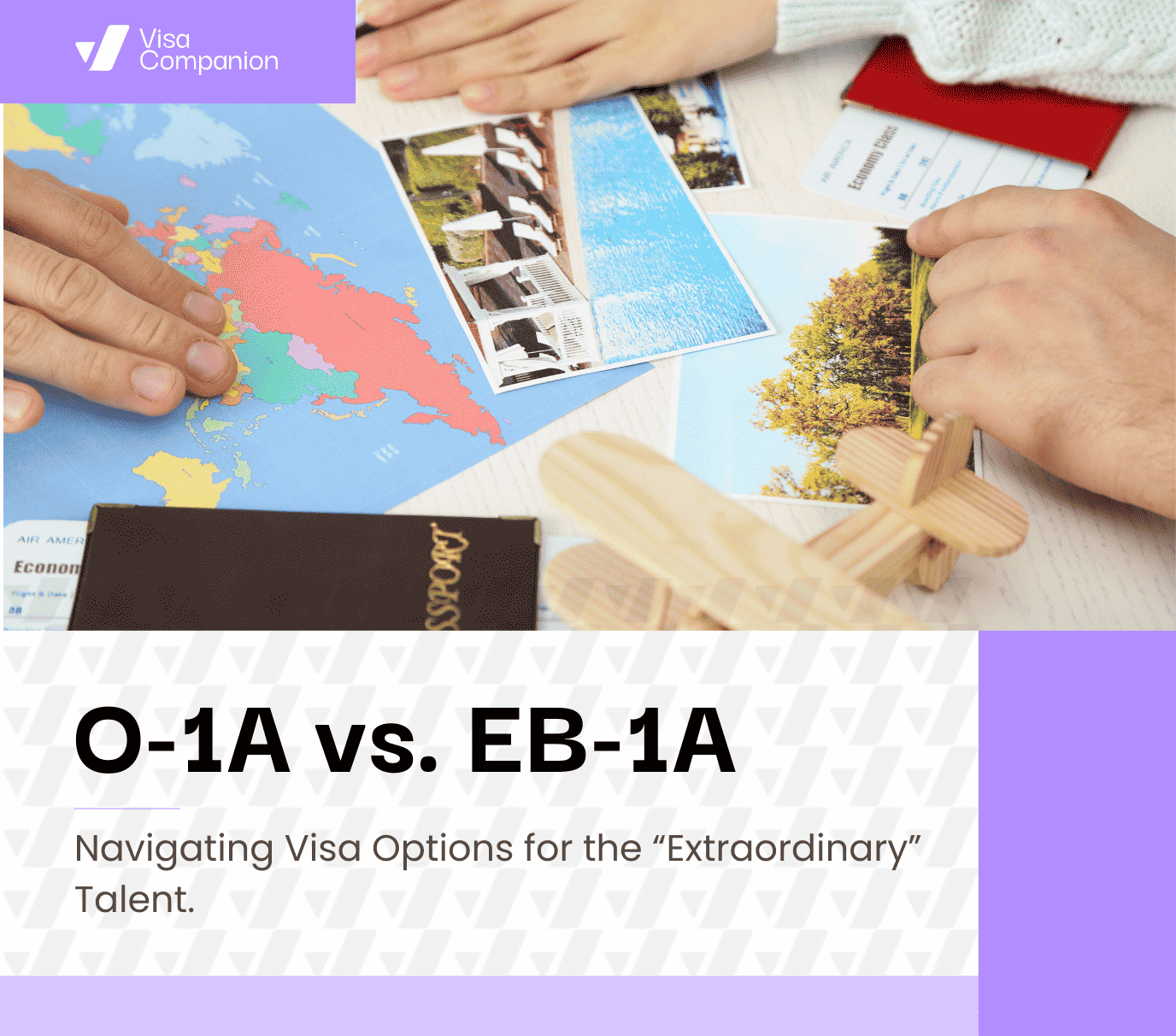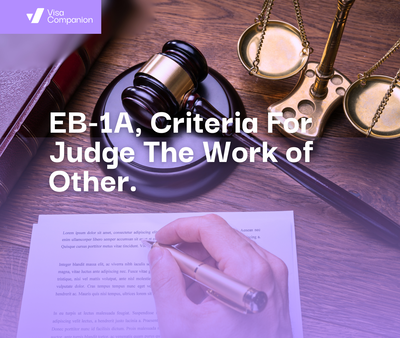EB1A: Are You a Leader in Your Field?

EB1A: Are You a Leader in Your Field?
Understanding whether you qualify for the EB-1A visa can be challenging, particularly when assessing if you have played a leading or critical role in a distinguished organization. This blog post aims to provide you with clear tools and insights to help evaluate and demonstrate your eligibility under this specific criterion, ensuring you present a compelling case to USCIS adjudicators.
When applying for an EB-1A visa, one of the most commonly used criteria is demonstrating that you have performed a leading or critical role in a distinguished organization. This criterion is particularly popular because it applies to a wide range of applicants. The logic is straightforward: if you are truly extraordinary in your field, then you are likely to be placed in a role that matches your exceptional talent and abilities within your organization.
To break it down, there are two key components to this criterion:
- Proving Your Role Was Leading or Critical: You need to show that the position you held was either a leading role, where you influenced major decisions and had significant authority, or a critical role, where your contributions were essential to the organization’s success.
- Proving the Organization Is Distinguished: It’s not just about your role but also about the organization you work for. The organization needs to be recognized as distinguished in its field, whether through its reputation, achievements, or standing in the industry.
When USCIS officers review EB-1A applications, they are essentially trying to measure the impact and value you brought to your organization. It’s your job to make this clear. However, this can be tricky because the adjudicators reviewing your case may not fully understand the intricacies of your job duties or the significance of your assignments. This is where your storytelling comes into play—you get to be the author of your narrative, ensuring that your impact and value are unmistakable.
Let’s consider what this might look like in practice. Perhaps you’re in charge of a critical function within your organization. Maybe you manage a team of top-tier professionals, design essential internal tools that streamline operations, or negotiate high-stakes contracts. Whatever your role, it’s crucial that you start gathering evidence now to demonstrate how it’s either leading or critical.
If you are arguing that your role is leading, your job title, position in the company hierarchy, responsibilities, and the people you oversee will all play a part in making that case. On the other hand, if you’re arguing that your role is critical, you’ll need to focus more on the specific impact your work has had on the organization. For instance, did your work lead to a significant increase in revenue? Did it improve operational efficiency? Did it drive innovation that set your organization apart from the competition?
In either case, the key is to clearly and convincingly show that your role was not just important but indispensable to the success of a distinguished organization. When you do this effectively, you significantly strengthen your case for EB-1A classification.
Imagine yourself sitting across from a USCIS officer, the fate of your EB-1A petition resting in their hands. They aren’t just glancing through your paperwork; they are scrutinizing every detail, looking for evidence that proves you are not just any professional, but an extraordinary one. They want to know if you’ve played a leading or critical role in your organization. And their questions are sharp, precise, and aimed at revealing the true impact of your work.
Is Your Role Leading? Is It Critical?
These are not just casual inquiries; they are the foundation of what the USCIS officer needs to determine. To convince them, you must be prepared to answer questions like:
- Have you taken on more than one leading or critical role?
- Is your impact felt across the entire organization or just within a specific part?
- Who have you led? What teams or departments fell under your guidance?
- Where do you stand in the organization’s hierarchy?
- Did you manage projects that had significant outcomes?
These questions aren’t just about listing your responsibilities; they’re about showcasing your influence. The officer wants to know if you’ve steered the ship or if you were merely a passenger. Were you the driving force behind your team’s success? Did your role involve managing others, assigning tasks, and ensuring the work met the organization’s high standards?
Evaluating the Prestige of Your Organization
But it doesn’t stop with your role. The USCIS officer will also turn their attention to the organization you worked for. They’ll ask:
- Is the organization distinguished or globally recognized?
- How long has the organization been established, and what is its reputation?
- How many employees are under its umbrella, and what is its market worth?
- Does this organization have substantial influence over its industry?
In other words, not only must you demonstrate that your role was pivotal, but you must also show that the organization itself is one of significance. The more distinguished the organization, the stronger your case becomes.
Building Your EB-1A Profile: Showcasing Your Leadership and Impact
Now, how do you paint this picture convincingly? Think creatively and strategically about the evidence you can gather. Here are some examples that can help solidify your case:
- Leadership Titles and Responsibilities: Provide evidence of the leadership positions you’ve held. Were you a manager, director, or VP? Detail the duties that set you apart from ordinary workers.
- Public Recognition: Include newspaper articles, journal publications, or any media coverage highlighting your role or specific projects.
- Official Documents: Share organization charts, internal newsletters, or any official documents that outline your position and contributions.
- Awards and Honors: If you’ve received awards or recognitions within your organization, showcase them. These highlight your extraordinary achievements.
- Salary Evidence: A high salary is often an indicator of a critical role. Provide evidence if your compensation reflects your leadership position.
- Emails and Reports: Don’t overlook emails that discuss important projects or accomplishments. Reports you’ve authored or presentations you’ve given can also serve as powerful evidence.
- Testimonials: Letters from senior leaders, especially those from CEOs, VPs, or other high-ranking officials, can make a strong case. These letters should explain your role, why it’s critical, and the impact you’ve had on the organization.
- Project Evidence: Provide details about the critical projects you’ve led. Include dates, locations, and the outcomes that underscore your contribution.
The key is to not just tell but to show. Demonstrate through concrete evidence how your role has been essential to the organization’s success. Highlight your unique contributions, the projects you’ve managed, and the teams you’ve led. Every piece of evidence should work together to build a compelling narrative of your leadership and the distinguished nature of your organization.
Conclusion: Crafting Your Narrative
As you prepare your EB-1A application, think beyond the basics. Consider the story your evidence tells about your career. Make it a story of leadership, of critical roles, and of undeniable impact. When the USCIS officer reviews your case, they should see not just a professional, but an extraordinary individual who has made a difference in their field.
Your success in this journey hinges on how well you can articulate and prove your leadership and the prestige of the organizations you’ve served. Start gathering your evidence now, and craft a narrative that leaves no doubt about your extraordinary abilities.
Mastering Your EB-1A Application: Highlighting Your Critical Role
When preparing your EB-1A application, it's essential to showcase the exceptional nature of the organizations where you've played a leading or critical role. Picture this: a USCIS officer flips through your application. What will make them pause, captivated by your story? What will convince them that your contributions are not just significant, but extraordinary?
To paint a compelling picture of your achievements, consider these types of evidence:
- Press Features: Has your organization made headlines? Include media coverage that highlights its innovations or accomplishments. This can serve as powerful proof of its impact and your role within it.
- Awards and Honors: If your organization has received accolades, showcase them. Industry-specific awards or broader recognitions speak volumes about the organization's high standing.
- Global Presence: Demonstrate the organization's international reach. Whether it operates in multiple countries or serves a global clientele, this information reinforces the significance of your role.
- Stock Listings and Financial Standing: If publicly traded, include stock listings or financial health information to bolster your case.
- Workforce Size: The number of employees can reflect an organization's scale and influence, adding another layer of distinction to your application.
- Rankings and Databases: Forbes rankings or Crunchbase profiles offer concrete proof of the organization's prestige, lending credibility to your claim.
- Humanitarian Achievements: If your organization has contributed significantly to humanitarian causes, highlight this. Show how these efforts have positively impacted the world.
- Online Biographies and Profiles: Provide links or screenshots of the organization’s biographic page to demonstrate its standing.
- Exclusive Positions: If securing your position was highly competitive, emphasize your exceptional qualifications and the difficulty of obtaining your role.
Remember, your EB-1A application is unique. Some cases may require only a few pieces of evidence, while others might need a more comprehensive approach to fully capture the scope of your achievements.
Critical or Leading Role: Tips for Success
Even for well-known organizations like Disney or Amazon, it’s crucial to back up their reputation with concrete evidence of distinction. When describing your role, avoid technical jargon. Imagine you’re explaining your work to a curious friend outside your industry—keep it clear and accessible.
To demonstrate your critical role, show how your contributions have made a significant impact. It’s not just about holding a senior position; it's about showing how your work has created a ripple effect, positively changing the world. Letters of commendation from government leaders or industry figureheads can be incredibly persuasive.
Even if you didn’t lead a team, if you were entrusted with a task that added immense value to the organization, you have a strong case. Remember, the essence of a critical role isn’t in the title—it’s in the impact.
Ultimately, USCIS must conclude that your achievements are truly exceptional. Given the high standards, it's no surprise that this category often sees a higher rate of RFEs, NOIDs, and even denials. But with careful preparation, clear presentation of evidence, and a compelling narrative of your impact, you can craft an EB-1A application that truly stands out.
Best of luck on your journey!
Our organization won’t charge you just for reaching out! If you would like your qualifications evaluated (to see if you qualify or to get ideas on what you can do to improve your EB-1 or NIW resume) please contact our firm at @visacompanion.ai
Related Blogs

Navigating EB2-NIW and EB-1A Visa Timelines: Strategies for Efficient Processing
June 2, 2023Understanding the processing times for EB2-NIW (National Interest Waiver) and EB-1A (Extraordinary Ability) visas is crucial for applicants aspiring to obtain these U.S. employment-based preference visas.

O-1A vs. EB-1A: Navigating Visa Options for the "Extraordinary" Talent
April 22, 2023Explore the differences between the O-1A and EB-1A visas for talented individuals immigrating to the US. Learn about the temporary, sponsored O-1A visa versus the permanent, self-petitioning EB-1A option. Gain clarity on which visa aligns best with your goals.

Maximize Your EB-1A Chances: Evaluate Your Memberships
Sept 19, 2024The goal of this post is to help you assess whether you can argue that you meet the second of the ten EB-1A criteria: holding a membership in an association that demands outstanding achievement from its members.

EB-1A - Judging the Work of Others
Sept 29, 2024One important criterion for the EB-1A visa is demonstrating that you have been asked to judge the work of others, either individually or as part of a panel. This post provides insights and tips to help you determine whether you can effectively argue that you meet this fourth criterion of the ten EB-1A criteria.